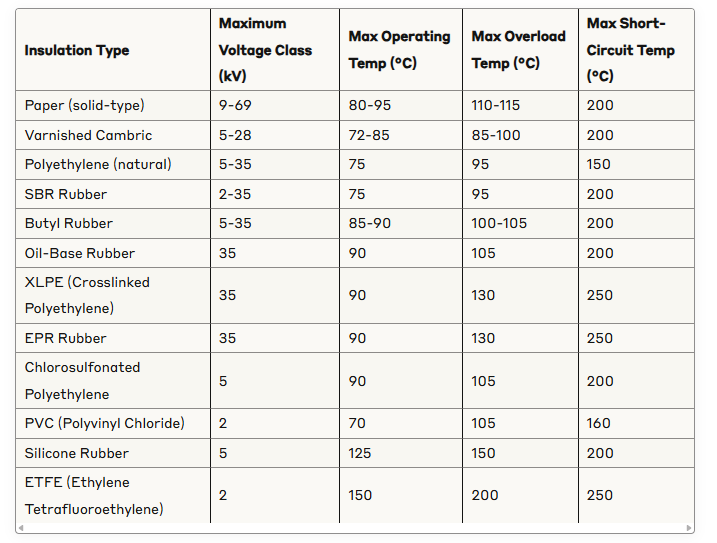📞+86 153 7530 2641 📧 hongjing.Wang@feichuncables.com

What Are the Rated Conductor Temperatures for Different Cable Insulation Types?
Discover the rated conductor temperatures for various cable insulation types, including XLPE, PVC, rubber, and ETFE. Learn how insulation temperature ratings affect performance, safety, and compliance with IEEE and IEC standards.
hongjing.Wang@Feichun
7/21/20256 min read


Understanding the thermal limits of electrical cables is fundamental to ensuring safe, reliable, and compliant electrical installations. The rated conductor temperature serves as a critical parameter that determines how much current a cable can safely carry under various operating conditions. This comprehensive guide explores the temperature ratings for different cable insulation types and their practical implications for electrical engineers, installers, and facility managers.
Introduction: Why Insulation Temperature Ratings Matter
The importance of conductor temperature ratings in cable design cannot be overstated. These specifications directly influence safety protocols, equipment lifespan, and overall electrical performance in any installation. When electrical current flows through a conductor, it generates heat due to resistance. The insulation material surrounding the conductor must withstand this heat without degrading, maintaining its electrical properties and structural integrity.
The connection between temperature ratings and safety is straightforward yet critical. Exceeding the maximum operating temperature of cable insulation can lead to premature aging, dielectric breakdown, and potentially catastrophic failures including fire hazards. Modern electrical systems demand precise temperature management to ensure optimal performance while meeting stringent safety standards.
Compliance with international standards like IEEE (Institute of Electrical and Electronics Engineers), IEC (International Electrotechnical Commission), and NBR (Brazilian Technical Standards Association) provides the framework for establishing these temperature limits. These organizations have developed comprehensive guidelines that account for material properties, environmental conditions, and application-specific requirements.
Understanding Key Temperature Ratings
To properly evaluate cable performance, it's essential to understand three distinct temperature classifications that define operational limits under different conditions.
Maximum Operating Temperature represents the standard operating limits for continuous use. This rating assumes normal load conditions and standard ambient temperatures, typically around 40°C. Under these conditions, the insulation material maintains its properties indefinitely without significant degradation.
Overload Temperature Rating defines how insulation handles short-term excess current situations. This rating applies to temporary conditions where the cable carries more than its rated current, such as motor starting or brief load spikes. Most standards limit overload conditions to a maximum of 100 hours per year to prevent cumulative thermal damage.
Short-Circuit Temperature indicates the tolerance during fault conditions when extremely high currents flow for brief periods, typically lasting only seconds. During these events, conductor temperatures can rise dramatically, and the insulation must withstand these extreme conditions without permanent damage or safety hazards.
These temperature classifications work together to provide a complete thermal profile for cable selection and application. Engineers must consider all three ratings when designing electrical systems to ensure adequate safety margins under all possible operating conditions.
Cable Insulation Types and Their Temperature Ratings
Different insulation materials exhibit varying thermal characteristics, making them suitable for specific applications and environmental conditions. The following insulation temperature rating chart provides detailed specifications for commonly used materials:


XLPE (Crosslinked Polyethylene) stands out as a superior insulation material with excellent thermal properties. Its crosslinked molecular structure provides exceptional resistance to thermal degradation, allowing continuous operation at 90°C and short-circuit temperatures up to 250°C. This makes XLPE ideal for high-power applications and harsh industrial environments.
PVC (Polyvinyl Chloride) represents the most economical option but with limited thermal capability. Its maximum continuous operating temperature of 70°C restricts its use to lower-power applications. However, PVC's ease of installation and cost-effectiveness make it popular for residential and light commercial applications.
Silicone Rubber offers unique advantages in applications requiring high flexibility combined with elevated temperature performance. Its ability to operate continuously at 125°C while maintaining flexibility makes it ideal for mobile equipment and applications with frequent movement.
ETFE (Ethylene Tetrafluoroethylene) provides extreme endurance under harsh conditions, with continuous operating temperatures up to 150°C and excellent chemical resistance. This material excels in corrosive environments and applications requiring long-term reliability under extreme conditions.
Comparative Analysis: Which Insulation for Which Application?
Selecting appropriate insulation requires careful consideration of application requirements, environmental conditions, and performance expectations. High-temperature cables using XLPE or ETFE insulation are essential in industrial processes involving elevated ambient temperatures, such as steel mills, refineries, or power generation facilities.
In harsh industrial environments or port crane applications, ETFE and XLPE provide superior performance due to their ability to withstand mechanical stress, chemical exposure, and thermal cycling. These materials maintain their properties under repeated heating and cooling cycles that would degrade lesser insulations.
When choosing insulation for short-circuit resilience, conductor overload temperature limits become critical factors. XLPE and EPR rubber, both capable of withstanding 250°C during fault conditions, provide the best protection for critical circuits where fault clearing times may be extended. PVC, with its 160°C short-circuit limit, requires faster protection systems to prevent insulation damage.
The decision between high-temperature and standard-duty cables often depends on load characteristics and environmental factors. Standard-duty cables using PVC or basic rubber insulations are adequate for stable loads in controlled environments. However, variable loads, frequent starting currents, or elevated ambient temperatures necessitate higher-rated insulations.
Standards and Compliance
International standards provide the foundation for temperature rating specifications and ensure consistent performance across different manufacturers and regions. IEEE standards, particularly IEEE 383 for nuclear applications and IEEE 1202 for flame testing, establish comprehensive testing procedures for thermal performance evaluation.
IEC standards, including IEC 60502 for power cables and IEC 60811 for common test methods, define standardized approaches to temperature rating determination. These standards ensure that cables meet consistent performance criteria regardless of their country of origin.
NBR standards provide localized requirements that may differ from international norms based on regional environmental conditions and regulatory frameworks. Local regulatory alignment is essential for ensuring compliance with national electrical codes and avoiding potential legal issues.
Temperature ratings must align with code requirements for conductor sizing, overcurrent protection, and installation methods. Proper derating calculations account for ambient temperature variations, cable bundling effects, and installation conditions that may affect thermal performance.
Common Pitfalls and Usage Notes
Several common mistakes can compromise cable performance and safety. Exceeding overload time limits represents a frequent oversight, with many installations unknowingly surpassing the 100 hours per year limit for elevated temperatures. Continuous monitoring and load management systems help prevent these violations.
Misjudging short-circuit ratings and resulting insulation damage often occurs when protection systems fail to clear faults quickly enough. Proper coordination between cable ratings and protective device settings ensures that fault currents are interrupted before reaching damaging temperature levels.
Overlooking ambient temperature derating can lead to dangerous operating conditions. When ambient temperatures exceed standard conditions, cable current-carrying capacity must be reduced according to established derating factors. Failure to apply these corrections can result in overheating and premature failure.
Installation practices significantly affect thermal performance. Poor cable spacing, inadequate ventilation, and improper conduit fill ratios can create localized heating that exceeds design parameters. Following manufacturer installation guidelines and industry best practices maintains the integrity of temperature ratings.
Conclusion and Recommendations
Understanding rated conductor temperatures for different cable insulation types is essential for safe and reliable electrical installations. The selection process should consider maximum operating temperatures, overload capabilities, and short-circuit resilience based on specific application requirements.
Best practices for insulation selection include thorough analysis of operating conditions, proper derating calculations, and compliance with applicable standards. Engineers should consider long-term performance requirements, environmental factors, and maintenance accessibility when making material choices.
For installers, adherence to manufacturer specifications and industry guidelines ensures that designed performance is achieved in practice. Regular inspection and monitoring of cable temperatures help identify potential problems before they become safety hazards.
The continuous evolution of insulation materials and testing standards requires ongoing education and awareness of new developments. Staying current with technology advances and regulatory changes ensures optimal performance and compliance throughout the system lifecycle.
Frequently Asked Questions
Q1: What does rated conductor temperature mean in cable specifications?
A: It refers to the maximum temperature a cable conductor can operate at continuously without degrading the insulation material.
Q2: How does insulation type affect a cable's maximum operating temperature?
A: Different insulation types (like XLPE, PVC, and rubber) have different thermal resistances, which directly impact their maximum safe operating temperature.
Q3: What is the difference between operating, overload, and short-circuit temperature ratings?
A: Operating temperature is for continuous use, overload temperature is for temporary excessive current (e.g., 100 hours/year), and short-circuit temperature applies to fault conditions lasting a few seconds.
Q4: Why is XLPE insulation preferred in high-temperature applications?
A: XLPE (crosslinked polyethylene) offers high thermal resistance, allowing it to perform reliably under conditions up to 250°C during short circuits.
Q5: Can exceeding the rated temperature damage the cable insulation?
A: Yes. Prolonged exposure to temperatures beyond rated limits can cause insulation breakdown, reduced lifespan, or even fire hazards.
Q6: Are rated conductor temperatures the same across all voltage classes?
A: Not necessarily. While insulation materials determine temperature ratings, the voltage class may influence the cable's overall thermal design and derating needs.
Q7: What insulation materials are suitable for short-circuit temperatures up to 250°C?
A: XLPE, EPR, and ETFE are commonly used for applications requiring short-circuit resilience up to 250°C.
Q8: How should I choose insulation type based on ambient temperature?
A: Derating must be applied if ambient temperatures are significantly higher than standard conditions. Use high-temperature-rated insulation in such environments.
Q9: What is the rated short-circuit temperature for PVC-insulated cables?
A: Most PVC cables are rated for a maximum short-circuit temperature of around 160°C, making them less suitable for extreme fault conditions.
Q10: Are there international standards that govern insulation temperature ratings?
A: Yes, organizations like IEEE, IEC, and NBR provide guidelines on insulation temperature limits, conductor sizing, and thermal endurance.
How to Reach Us
Get in Touch
SiteMap
Product Catalogue
Reeling Cable
Festoon Cable
Shore Power Cable




Scan to add us on WeChat
